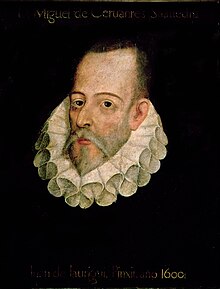Juan de Jáuregui
- There are other people known as Juan de Jáuregui.
Juan Martínez de Jáuregui y Aguilar (also known as Juan Martínez de Jáuregui y Hurtado de la Sal)[1][2] (November 24, 1583 - January 11, 1641), Spanish poet, scholar[2] and painter in the Siglo de Oro.
Biography
Juan Martínez de Jáuregui y Hurtado de la Sal was born and baptized in Seville, Andalusia. His parents were Miguel Martínez de Jáuregui, a hidalgo—which is an untitled Spanish nobleman—from La Rioja, and Doña Isabel de la Sal from Seville. He was the fifth of their ten children; the oldest became later commissioner (regidor) of Seville. The poet changed his second name (the one coming from his mother) to "Aguilar," coming from one of his grandmothers.[3]

About his youth very little is known. In his discourse "Arte de la pintura" ("The art of painting") some references to various travels to Italy can be found and it is known that he stayed in Rome, probably to study painting.[4] He returned to Spain shortly before 1610 with a reputation as both a painter and a poet. A reference in the preface to the Novelas exemplares has been taken to mean that he painted the portrait of Cervantes, who, in the second part of Don Quixote, praises the translation of Tasso's Aminta published at Rome in 1607.
Jáuregui's Rimas (1618), a collection of graceful lyrics, where he integrated also some translations of Horace, Martial and Ausonius,[3] is preceded by a controversial preface which attracted much attention on account of its outspoken declaration against the culteranismo of Luis de Góngora. Another Spanish poet, Francisco de Quevedo, mentioned Jáuregui in "La Perinola" with scorn.
Through the influence of Gaspar de Guzmán, Count-Duke of Olivares, he was appointed groom of the chamber to Philip IV, and gave an elaborate exposition of his artistic doctrines in the Discurso poético contra el hablar culto y oscuro (1624), a skillful attack on the new theories, which procured for its author the order of Calatrava. It is plain, however, that the shock of controversy had shaken Jáuregui's convictions, and his poem Orfeo (1624) is visibly influenced by Góngora.
Jáuregui died at Madrid on the January 11, 1641, leaving behind him a translation of the Pharsalia which was not published until 1684. This rendering reveals Jáuregui as a complete convert to the new school, and it has been argued that, exaggerating the affinities between Lucan and Góngora—both of Córdoban descent — he deliberately translated the thought of the earlier poet into the vocabulary of the later master. This is possible; but it is at least as likely that Jáuregui unconsciously yielded to the current of popular taste, with no other intention than that of conciliating the public of his own day.
Bibliography
- Rimas (1618) — A collection of lyrics.
- Discurso poético contra el hablar culto y oscuro (1624)
- Antídoto contra la pestilente poesía de las Soledades (1624)
- Apología de la verdad (1625)
- Orfeo (1624)
- Pharsalia (1684)
See also
Notes
- ^ "Juan Martínez de Jáuregui y Hurtado de la Sal (1583-1641)". Enciclopedia Universal Multimedia. Retrieved 14 September 2012. Template:Es icon
- ^ a b "De Jáuregui y Aguilar, Juan". Liste des humanistes espagnols (“List of Spanish humanists”). Europa Humanistica. Retrieved 14 September 2012. Template:Fr icon
- ^ a b Template:Translation/Ref
- ^ Template:Translation/Ref
References
- This article incorporates text from a publication now in the public domain: Chisholm, Hugh, ed. (1911). "Jáuregui y Aguilar, Juan Martínez de". Encyclopædia Britannica (11th ed.). Cambridge University Press.
External links
- The Exemplary Novels of Cervantes with a reference to Jáuregui in the author's preface.
- . Encyclopedia Americana. 1920.
